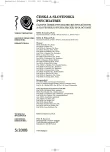Circadian Rhythms in Major Depressive Disorder
Authors:
L. Vavrušová
Authors‘ workplace:
Psychiatrická klinika SZU, FNsP, Bratislava
Published in:
Čes. a slov. Psychiat., 104, 2008, No. 5, pp. 241-245.
Category:
Comprehensive Reports
Overview
Treating the circadian alterations of mood disorders with chronobiotic agents is a new, promising therapeutic approach, and is a further step in the understanding of depression.
Agomelatine, the first melatonergic antidepressant, represents a novel pharmacological approach, and is a further step in understanding depression. Agomelatine is a new agent that enhances norepinephrine and dopamine neurotransmission by a unique mechanism, namely 5-HT2C antagonism with melatonin receptors 1 and 2 agonism.
Key words:
agomelatine, antidepressant, novel mechanism of action.
Sources
1. Bunney, B. G., Potkin, S. G., Bunney, W. E.: Dysregulation of circadian rhythms in mood disorders: Molecular mechanisms, biology of depression. From Novel Insights to Therapeutic Strategies. Edited: Julio Licinio and Ma-Li Wong, Wiley-Vch Verlag, 2005.
2. Hamon, M., Millan, M. J.: Agomelatine, a novel pharmacological approach for treating depression, Eur. Neuropsychopharmacol., 16, 2006 (Suppl 4), S337, Abstract P. 2. 009.
3. Höschl, C.: Chronobiologie v lékařství. Bratislavské lekárske listy, 90, 1989, s. 300-398.
4. Höschl, C.: Chronobiologie. Psychiatrie, Ed.: Höschl C, Libiger J, Švestka J. Tigis, 2002, 895 s.
5. Kennedy, S. H., Emsley, R.: Placebo controlled trial of agomelatine in the treatment of major depressive disorder, European Neuropsychopharmacology, 16, 2006, pp. 93-100.
6. Leproult, R., Van Ondergergen, A., L.´Hermite-Balériaux, M., Van Cautert, E., Copinschi, G.: Phase-shift of 24-h rhytms of hormonal release and body temperature following early evening administration of the melatonin agonist agomelatine in healthy older men. Clin. Endocrinol, 63, 2005, pp. 298-304.
7. Lewy, A. J., Lefler, B. J., Emers, J. S., Bauer, V. K.: The circadian basis of winter depression. Proceedings of the National Academy of Sciences, USA, 103, 2006, pp. 7414-7419.
8. Loo, H., Hale, A. D´Haenen, H.: Determination of the dose of agomelatine, a melatonergic agonist and selective 5HT2C antagonist in the treatment of major depressive disorder: a placebo –controlled dose range study. International Clinical Psychopharmacology, 17, 2002, pp. 239-247.
9. Millan, M. J., Brocco, M., Gobert, A., Dekeyne, A.: Anxiolytic properties of Valdoxan, an antidepressant with melatonergic and serotonergic properties: role of 5-HT2C receptor blocade. Psychopharmacology, 177, 2005; pp. 448-458.
10. Millan, M. J., Gobert, A., Lejeune, F. et al.: The novel melatonin agonist Valdoxan (S20098) is an antagonist at 5-hydroxytryptamine 2c receptors, blocade of which enhances the activity of fronto-cortical dopaminergic and adrenergic pathways. J. Pharmacol. Exp. Ther., 306, 2003, pp. 954-964.
11. Olié , Kasper, S.: Efficacy of agomelatine, a M1/M2 receptor agonist with 5-HT2C antagonistic properties, in major depressive disorder. Neuropsychopharmacology. Published online: 4. May 2007. doi:10.1017/S1461145707007766.
12. Papp, M., Gruca, P., Boyer, P. A., Mocaër, E.: Effect of Valdoxan in the chronic mild stress model of depression in rat. Neuropsychopharmacology, 28, 2003, pp. 694-703.
13. Simon, M., Schmelting, B., Mocaër, E., Fuchs, E.: Agomelatine restores sleep EEG activity in chronic psychosocially stressed tree shrews, Neuroscience, 2004, pp.24-27.
14. Stahl, M. S.: Novel mechanism of antidepressant action: noerepinephrine and dopamine disinhibition (NDDI) plus melatonergic agonism, International Journal of Neuropsychopharmacology, 10, 2007, pp. 575-578.
15. Wirz-Justice, A.: Chronobiology and mood disorders. Dialogues Clin. Neurosci., 2003; 5, pp. 315-325.
Labels
Addictology Paediatric psychiatry PsychiatryArticle was published in
Czech and Slovak Psychiatry

2008 Issue 5
- Memantine in Dementia Therapy – Current Findings and Possible Future Applications
- Memantine Eases Daily Life for Patients and Caregivers
- Hope Awakens with Early Diagnosis of Parkinson's Disease Based on Skin Odor
- Deep stimulation of the globus pallidus improved clinical symptoms in a patient with refractory parkinsonism and genetic mutation
Most read in this issue
- Dissociation in Childhood: Clinical Manifestation and Diagnosis Child Dissociative Checklist
- Catamnestic Observation of the Efficacy of Substance Dependence Treatment Program
- Criminal Liability Assessment in Defendants with History of „Schizophrenia“ - Case Study of Institutional Revision Report
- Circadian Rhythms in Major Depressive Disorder
